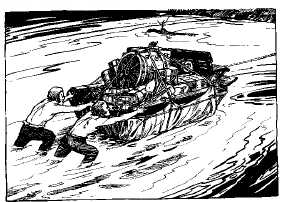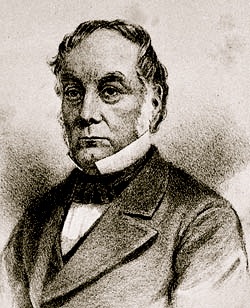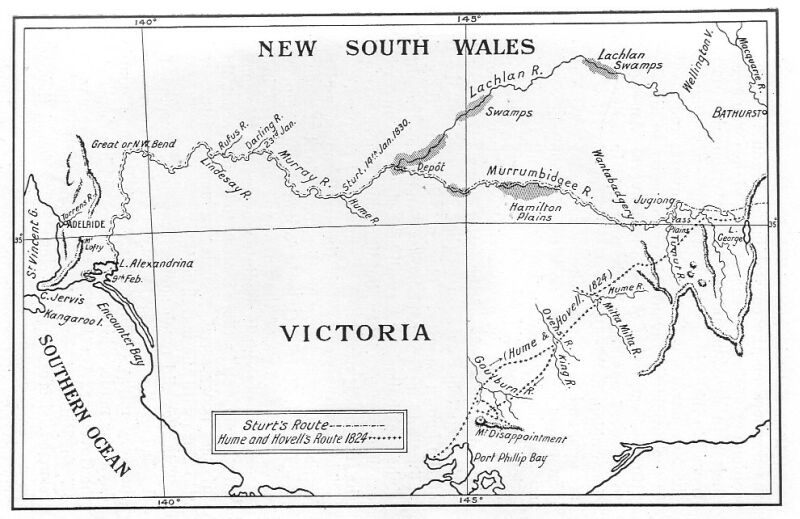Hume and Hovell were explorers.
They explored eastern Australia.
They travelled from New South Wales to Port Phillip Bay in Victoria.
They arrived at, and named, the Hume River (it is now named the Murray)
The route of their expedition is now the Hume Highway from Sydney to Melbourne via Albury.
Hamilton Hume (1797- 1872)
Hume©Getty
Hamilton Hume was the first Australian-born explorer. He was born in Parramatta, New South Wales on 18 June 1797. He had a good knowledge of bushcraft, and by the age of 17 was exploring, first to the Berrima district (between Sydney and Canberra), then with Surveyor Meehan to the Goulburn Plains and Lake Bathurst.
Over the next few years he was a member of several exploring parties, to Yass Plains and the tablelands near Braidwood.
William Hovell (1786-1875)
Hovell ©Getty
William Hovell was born in Norfolk, England. He joined the Royal Navy and became a captain.
In October 1813, he moved to New South Wales, Australia with his wife Esther Arndell. He got work as a ship’s captain and made several trading trips along the coast and to New Zealand. He was once shipwrecked in Bass Strait.
The Hume and Hovell expedition
In 1824, Governor Brisbane asked Hume to join forces with Hovell, to go from Lake George to the Spencer Gulf (in what is now South Australia). Hovell was older than Hume, with little bush experience, but he was a good navigator.
The expedition left Lake George on 17 October 1824, with a party of six, enough supplies to last 16 weeks loaded onto bullock carts, and horses and dogs (which they used to hunt kangaroos). The first two weeks of the journey was through areas that had already been explored. They reached the Murrumbidgee River to find it was in flood. They waited for three days before they could cross it, using one of the carts as a boat, and then found themselves in mountainous country. Some slopes were so steep that they had to zig zag their way up. They left the carts behind and loaded supplies onto the bullocks, and continued on.
Hume and Hovell were the first white men to see Australian Alps.©Getty
It took some time to find a pass through the ranges. However, when they reached the top, they gazed at a sight that no white man had seen: the Australian Alps.
They had to travel to the west to avoid them. The weather became warmer, and they were pestered by flies, mosquitoes, ticks and leeches. By 16 November they reached another river, which they named the Hume, but which was later renamed the Murray.
They saw large numbers of water birds such as pelicans and swans feeding on seafood which was plentiful. The river was very wide and the water was clear and deep. In order to cross this river, they made a boat from some poles and tarpaulins, and pulled the animals across on ropes. Near the Murray, at the place that is now Albury, the explorers carved their names on a tree on 17 November 1824. The tree was called the Hovell Tree.
The plaque duplicating the carved words was re-created in the 1980s, and is called a ‘clone’ of the plaque, mounted on a special monument. Click on this link to see it:
https://read-the-plaque.appspot.com/plaque/clone-of-the-original-hovell-tree
They continued on to the southwest, travelling through forest country. They saw a snowy peak to the east, and named it Mt Buffalo.
Travelling through the Ovens Valley, Hovell wrote, 'There are fine hills and grassland...as pretty a spot and as valuable as any I have seen since leaving home.'
Hume wrote, 'The honeysuckle and grass trees are growing here well – we find the land to be good.'
The party crossed the Eastern Highlands, passed Mt Disappointment and Mt Macedon and crossed the Werribee River. At last they reached the sea: they were at Corio Bay in Port Phillip, the place that is now the city of Geelong. Because their instruments had been damaged, their calculations were incorrect, and they thought they were in Westernport when in fact they were at Port Phillip. The Aboriginal people in the area called the bay 'Jillong' and the land 'Corio', or at least this is what Hume and Hovell understood from their attempted conversation.
As supplies were running low, the expedition set off for home the next day. The journey home was easier. In summer, the flooded rivers had become shallow puddles. They collected their carts from where they had left them, but the ground was now too rough for the bullocks, which had to be abandoned in the bush. They arrived at Lake George on 18 January. The three month expedition had found much open land suitable for farming and grazing between Sydney and Port Phillip.
WikiCommons
In 1828 Hume joined Charles Sturt's expedition when he named the Darling River, but because of ill health, he retired to his properties in Yass and did no more exploring.
William Hovell died on 9 November 1875, at Goulburn, New South Wales.
How are they remembered?
A dam was built on the King River in Victoria in 1973. This formed Lake William Hovell.
The highway from Melbourne to Sydney is called the Hume Highway.





